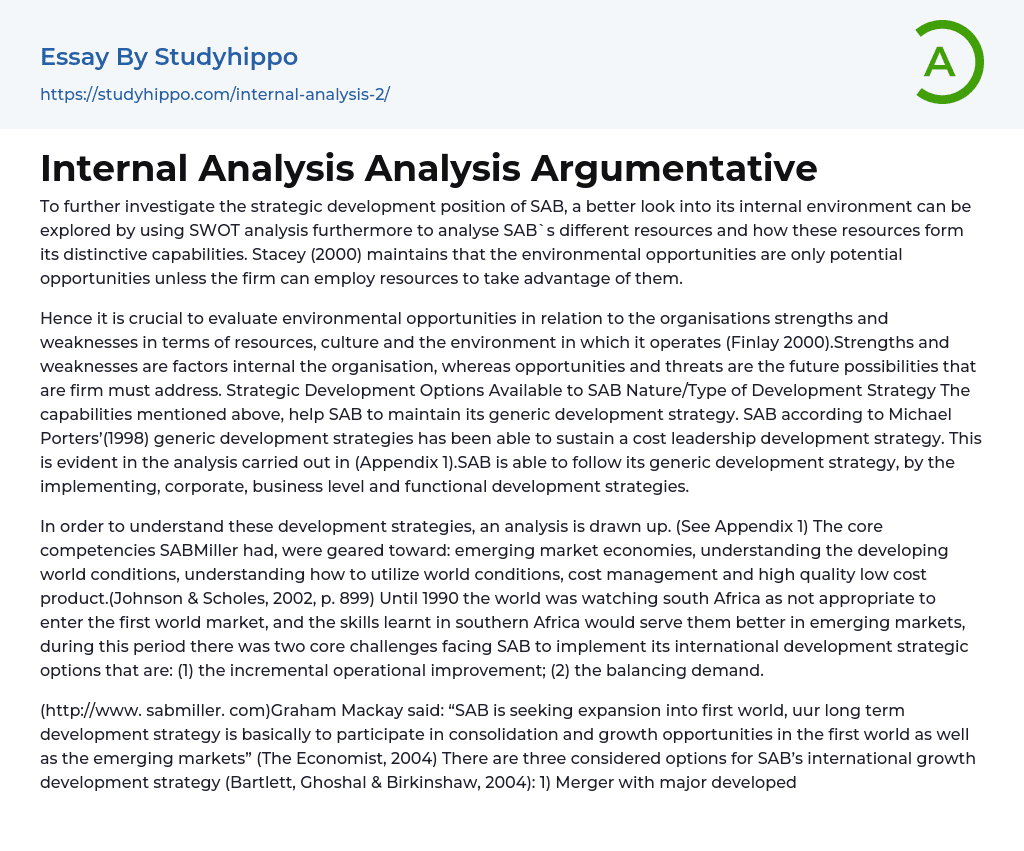In order to examine the strategic development position of SAB more deeply, it is possible to explore its internal environment using SWOT analysis. Additionally, SAB's distinct capabilities can be analyzed by examining its various resources. Stacey (2000) argues that environmental opportunities are meaningless unless a company has the necessary resources to utilize them.
Therefore, assessing environmental opportunities is crucial for evaluating an organization's strength and weaknesses in terms of resources, culture, and operating environment (Finlay 2000). Strengths and weaknesses are internal factors, while opportunities and threats relate to future possibilities that firms must address. SAB has capabilities that enable it to maintain its generic development strategy. As per Michael Porter's (1998) generic development strategies, SAB has been able to sustain a cost leadership development strategy, which is evident in the analysis carried out in Appendix 1. To implement its generic development strategy, SAB ca
...n use corporate, business-level, and functional development strategies.
An analysis is conducted to comprehend these development strategies which are supported by SABMiller's core competencies. These competencies are focused on emerging market economies, understanding developing world conditions, utilizing world conditions, cost management, and producing high quality low cost products (Johnson & Scholes, 2002, p.899). Prior to 1990, South Africa was not considered suitable for entering the first world market. During this time, SABMiller learned crucial skills that have proven useful in emerging markets. However, the implementation of SAB's international development strategic options was hindered by two main challenges: (1) incremental operational enhancement and (2) balancing demand. For further details, see Appendix 1.
(http://www.sabmiller.com) According to Graham Mackay, SAB's long-term development strategy involves expanding into both first-world and emerging markets by participating in consolidation
and growth opportunities. SAB considered three options for international growth development strategy, as outlined by Bartlett, Ghoshal & Birkinshaw (2004): merger with a major developed country brewer, acquisition in emerging markets or continued focus on organic growth in emerging markets. SAB chose to pursue the merger development strategy which led to its acquisition of 100% of Miller Brewing through an agreement with Phillip Morris Company Inc. This resulted in a name change to SABMiller and made them the second largest brewer in the world by volume with over 69000 employees. The merger has also given SAB access to the most important market for the brewing industry, the US.
According to http://www.sabmiller.com, the transaction has been greatly advantageous for SABMiller, particularly in the long term. To ensure the successful implementation of generic development strategies and prevent any issues, it is important to assess their alignment with both the organizational structure and culture. Additionally, it is essential to evaluate whether the current resources are suitable for implementing these strategies, as previously mentioned.
(McGee, Thomas & Wilson, 2005) state that SAB is a diversified/divisionalised organisation according to Mintzberg's (2003) structural types of configurations. SAB operates in 23 countries within the brewing industry, with Castle beer as its core product and a highly diversified product portfolio.
Assuming that managers are assigned by the headquarters to coordinate dispersed activities across countries and moderate capital investment is made in national and international product divisions to standardize production procedures, it can be inferred that SAB's factories achieve high economies of scale and scope with cost-efficient production procedures. This structure also facilitates synergies among the different business units. It should be noted, however, that SAB
produces a portfolio of drinks customized to each country of operation.
The flexibility provided by SAB's decentralization allows for rapid responses to changes in demand across various markets. This approach helps to mitigate risks from a downturn in demand in a single region, such as adverse weather conditions in Tanzania or economic troubles in Romania, which were successfully offset by the notable growth in Poland and China (Business Week, 2004). However, this delayered structure also presents potential challenges with managing individual business units efficiently. To mitigate these risks, SAB holds consistent meetings between headquarters and its diverse units to facilitate strong information flows. Additionally, SAB could consider investing in network systems that are suitable for coordinating every business unit globally.
In order for SAB to successfully implement its group development strategies, it is important to consider the organizational structure and culture. As noted by McGee, Thomas, and Wilson in Chapter 13, the characteristics of the organizational structure play a significant role in this process. Additionally, it is important to examine the organizational culture to ensure that it aligns with the development strategy pursued by SAB.
The dominant culture at SAB is reflected in three key concepts: communication, motivation, and teamwork. Our findings suggest that integrating the company's organizational culture into acquired companies aligns with our growth strategy.
- John Locke essays
- 9/11 essays
- A Good Teacher essays
- A Healthy Diet essays
- A Modest Proposal essays
- A&P essays
- Academic Achievement essays
- Achievement essays
- Achieving goals essays
- Admission essays
- Advantages And Disadvantages Of Internet essays
- Alcoholic drinks essays
- Ammonia essays
- Analytical essays
- Ancient Olympic Games essays
- APA essays
- Arabian Peninsula essays
- Argument essays
- Argumentative essays
- Art essays
- Atlantic Ocean essays
- Auto-ethnography essays
- Autobiography essays
- Ballad essays
- Batman essays
- Binge Eating essays
- Black Power Movement essays
- Blogger essays
- Body Mass Index essays
- Book I Want a Wife essays
- Boycott essays
- Breastfeeding essays
- Bulimia Nervosa essays
- Business essays
- Business Process essays
- Canterbury essays
- Carbonate essays
- Catalina de Erauso essays
- Cause and Effect essays
- Cesar Chavez essays
- Character Analysis essays
- Chemical Compound essays
- Chemical Element essays
- Chemical Substance essays
- Cherokee essays
- Cherry essays
- Childhood Obesity essays
- Chlorine essays
- Classification essays
- Cognitive Science essays




